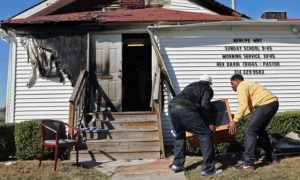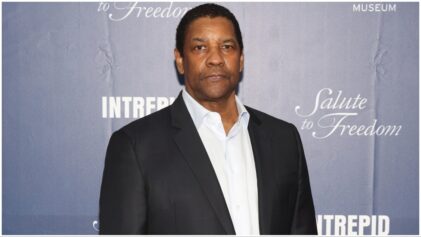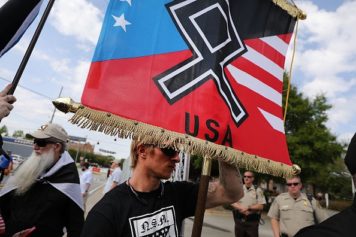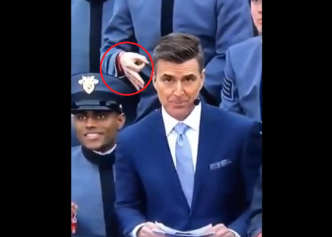
Deacon Clinton McMiller, left, and Pastor David Triggs carry a cabinet back into the church after a fire at the New Life Missionary Baptist church in St Louis on 18 October. Photograph: JB Forbes/AP
A seventh church in St. Louis has been set on fire since October 8, in a region that has been rocked by the events in Ferguson and the national debate over police violence against Black people. Some of the victims of the arson attacks lament that the authorities and the faith community are not responding more forcefully.
Six of the seven churches targeted in recent weeks are predominantly African-American. The seventh, Shrine of St. Joseph, is not a Black church and has a mostly white congregation, nor is it located in the same neighborhood as the other houses of worship. However, as CNN reported, the Columbus Square neighborhood in which the church is located is 90 percent Black, according to the 2010 census. Like the other churches, no one was present when the fire was set, and the fire occurred at a double-door entry, which caused “very similar type of damage” to the other churches.
The Jesuit church, founded in 1843 by German immigrants, is known for “the only authenticated miracle in the Midwest” in which immigrant Ignatius Strecker reportedly recovered from a long illness after praying to St. Peter Claver (1581-1654), a priest who became the patron saint of enslaved Africans. In 1979, the church pastor was murdered when three intruders broke into the church and stole a bottle of altar wine.
Meanwhile, Rev. Rodrick Burton of one of the other New Northside Missionary Baptist church senses “lethargy” in the community and told the Guardian he “expected more of a response” from the faith community to the fires.
“A number of the congregation are people who lived through an era where church fires were not taken seriously by the authorities,” Burton said. “I got folks from Arkansas, my mother’s from Alabama, for some of the people, they’re waiting to see what is the motivation [behind the fires].”
Rev. Burton added, “But I say that it could’ve [done more] for race relations across this area … if people of the majority culture reached out and said, ‘We’re concerned about this happening in the African American community.’”
However, Burton was buoyed by the response of Shrine of St. Joseph. At Sunday services, Rev. Dale Wunderlich asked congregants to donate to the other burned churches, as parishioners filled collection baskets.
“We are now part of a bigger picture,” Wunderlich told his congregation. “It seems to me that we can’t sit back and do nothing.”
The St. Louis church burnings come as a report from Pew Research Center finds that half of all fires at houses of worship in the past 20 years were intentionally set. Of the 4,705 reported fires at religious institutions between 1996 and 2015, 2,378, or 51 percent were ruled intentional as of July. As of July 14, the Bureau of Alcohol, Tobacco, Firearms and Explosives (ATF) ruled 29 of 79 church fires in 2015 to be arson, with some investigations ongoing. According to Pew, fires caused by arson are far more common in churches than in other buildings.
White supremacists have targeted Black churches since the days of slavery, when angry whites burned down Emanuel AME Church in Charleston, South Carolina for its role in the Denmark Vesey slave revolt. Emanuel AME, of course, fell prey to Dylann Roof, a white supremacist who shot nine Black church members to death on June 17, 2015. Church burnings were common during the civil rights movement, with the 1963 bombing by the Ku Klux Klan of the 16th Street Baptist Church in Birmingham, Alabama—which killed four Black girls– as a most prominent example. With an epidemic of Black church arsons in the 1990s, President Clinton signed the Church Arson Prevention Act in 1996, and the National Church Arson Task Force was established.
Earlier this year, the Department of Homeland Security issued a report warning about the terror threat posed by “right-wing sovereign citizen extremists.” As Media Matters reported, DHS described the domestic terrorists as people “who believe that they can ignore laws and that their individual rights are under attack.” In October, John Carlin, assistant attorney general and head of the National Security Division at the Department of Justice, warned that domestic terrorist groups, not unlike ISIS, are a real threat and are spreading through social media. He added that white extremists are feeling marginalized as whites become a numerical minority in the U.S.


